Further into the equatorial rain-forest...
* Profundizando en la selva ecuatorial...
* Profundizando en la selva ecuatorial...
In Misahualli, Napo province, we stayed at the guesthouse France Amazonia. Its owner, Antoine, bade us a very warm welcome. The place was wonderful, very comfortable and the best part was that in the evening we were sung to sleep by the river, because it is located on the shore of the Napo. In the morning we marveled at the local vegetation that surrounded us...
* En Misahualli provicia del Napo nos hospedamos en la casa de huéspedes France Amazonia, Antoine su propietario nos ofreció una muy cálida bienvenida. El lugar fue estupendo, muy confortable y lo mas hermoso: por la noche dormimos con el canto del río, ya que se encuentra ubicado a orillas del Napo y por la mañana nos maravillábamos rodeados de la vegetación local...
One of
the typical dishes of the Amazon region is fried chontacuro with chili sauce.
The chontacuro is a worm that grows in the core of the chonta tree. The natives
eat this worm, considered a nourishment of high protein content, for its
natural fat. They attribute healing properties to it, mothers for example, use
it to cure infections of the tongue and throat of children, they say that it
relieves coughing and asthma. Although it doesn't look very appetizing to many,
we have to admit that it tastes quite good, more or les like pork rind...
* Uno de
los platos típicos en la región amazónica es el chontacuro frito
con salsa de ají. El chontacuro es un gusano que crece en
el corazón del árbol de chonta. Los indígenas consumen este gusano
considerado como un alimento de alto contenido proteínico por su
grasa natural. Le atribuyen propiedades curativas, las madres por
ejemplo los emplean para sanar infecciones de la lengua y garganta en
los niños, dicen que alivia la tos y el asma. Aunque a la vista de muchos no se vea
muy apetitoso, debemos admitir que el sabor es bastante bueno mas o
menos como un chicharrón de cerdo...
Down the Napo river...
The Napo River runs through the Amazon territories of
Ecuador and Peru and is one of the main tributaries of the Amazon River. It is
1,130 km long. It has its sources on the flanks of the Cotopaxi volcano and the
oriental highlands and foothills of the National Park Llanganates. After
leaving the mountain range of the Ecuadorian Andes it enters the great
Amazonian plain.
The Napo was the first affluent of the Amazon River
discovered by the Spanish explorers: between 1540 and 1541 Gonzalo Pizarro
sailed on this river and an expedition led by Francisco de Orellana went down
the Napo and the Amazon till it reached the Atlantic Ocean.
* Bajando por el río Napo...
El río Napo recorre los territorios
amazónicos de Ecuador y del Perú, es uno de los principales
afluentes directos del río Amazonas. Tiene una longitud de 1.130 km. Las fuentes del río Napo nacen al pie
del volcán Cotopaxi, y de los páramos y estrivaciones montañosas
orientales del Parque Nacional Llanganates. Tras romper la cordillera
montañosa de los ándes Ecuatorianos se adentra en la gran llanura
amazónica.
El Napo fue el primero de los afluentes
del río Amazonas descubierto por los exploradores españoles: entre
1540 y 1541 Gonzalo Pizarro navegó por este río y una expedición
dirigida por Francisco de Orellana descendió por el Napo y el
Amazonas hasta alcanzar el océano Atlántico.
Exploring a little piece of the Amazon...
The Amazon ecosystem, especially its tropical rainforest, contains the world's richest and most complex vegetal and animal habitats. In the existence of a prolific flora and fauna and extraordinary variations of macro and micro habitat lies the most important feature of this region.
* Explorando un trocito de la amazonia...
El ecosistema amazónico, en especial
su bosque tropical lluvioso, contiene los hábitat vegetales y
animales más ricos y complejos del mundo. La existencia de una prolífica flora y
fauna junto a extraordinarias variaciones de macro y micro hábitat
radica la característica más importante de esta región.
We sail on until we find one of the many families extracting gold from the river in a traditional way...
* Seguimos navegando hasta encontrar una de las muchas familias que se dedican de manera artesanal a buscar oro en el río...
Along the river several native communities could be seen, like this Quichua one we visited. We had the privilege of observing the community, some of its art and customs.
* Alrededor del río, se
podrán observar varias comunidades indígenas como esta Quichua a la
cual visitamos. Tuvimos el privilegio de observar su comunidad, algo
de su arte y sus costumbres.
Our dear explorer Taro had a little accident with an Amazon bug...
* Nuestro querido explorador Taro tuvo un pequeño
percance con un bicho amazónico ...
Back in Misahualli...
* De regreso a Misahualli...
We returned by nightfall, a refreshing dive in the hotel's swimming pool, a wonderful campfire accompanied by jungle sounds and later on a few of our songs...
* Llegamos al anochecer, un refrescante baño en la piscina del hotel, una fogata maravillosa acompañada de los sonidos de la selva y mas tarde un par de canciones nuestras...



















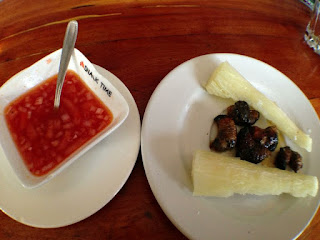

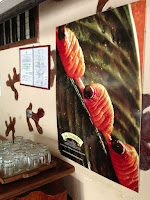

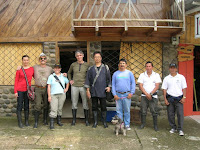























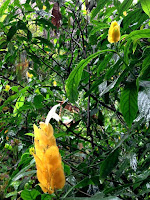






























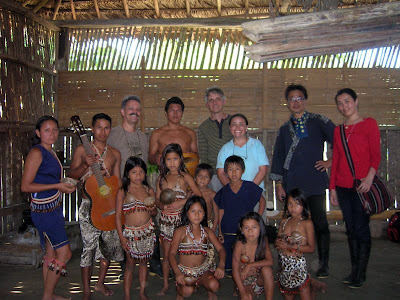




















No comments:
Post a Comment